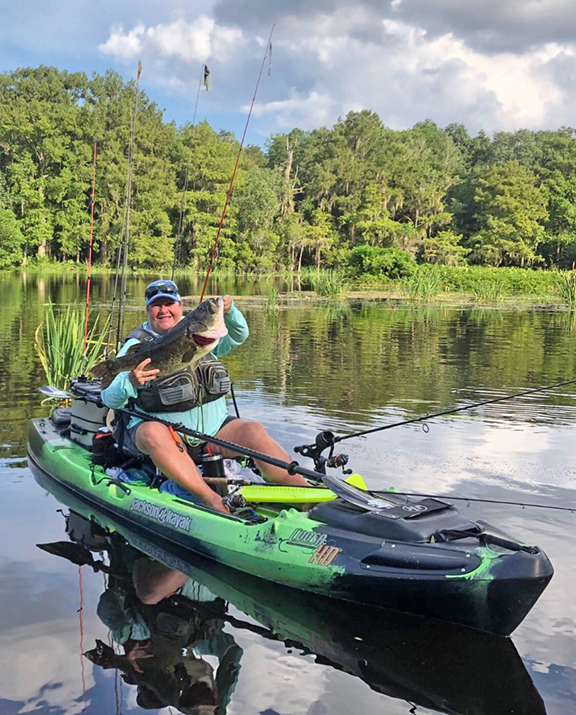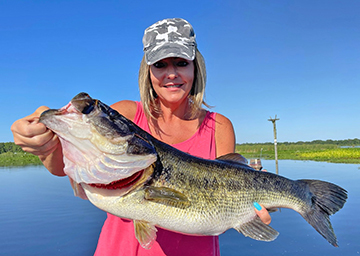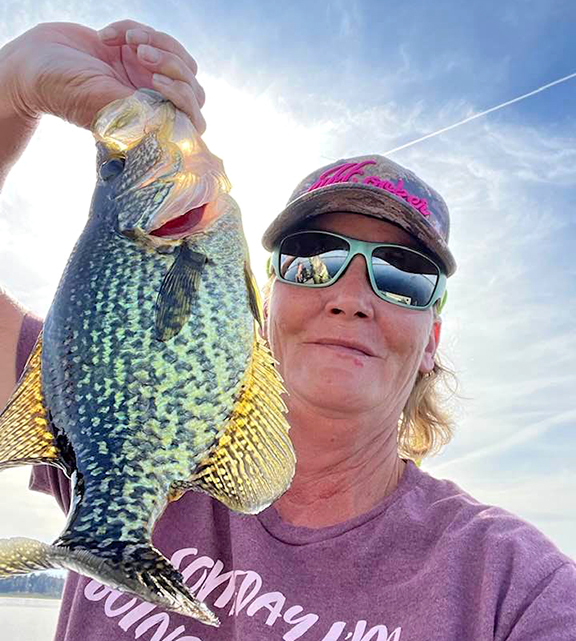|
TrophyCatch Hall of Fame Champion Grant Smelcer caught and released a 14-pound, 4-ounce bass from Porter Lake in Washington County.
TrophyCatch ended the year with a bang as we wrapped up Season 10 activities! Besides rewarding the catch-and-release of more than 13,500 trophy Florida bass since the program started in 2012, several other highlights capped off a tremendous Season 10.
Angler Dale Dew (in the orange hat) landed the first 10-Tag Celebration pink-tagged bass as well as the 10-Tag Grand Prize of $10,000!
TrophyCatch participant Dale Dew was not only the first angler to catch one of the 10-Tag Celebration bass with a pink tag, but also landed the 10-Tag Grand Prize of $10,000. Thank you to all anglers who participated and targeted a pink-tagged bass and helped TrophyCatch celebrate 10 years of success. Special thanks to Bass Pro Shops and AFTCO for supporting this special celebration.
The Phoenix Boats package offers one sweet bass fishing ride!
Michael Hendren from Winchester, Virginia was our Season 10 Phoenix Boats winner! This incredible boat package is powered by Mercury Marine, guided by Lowrance, anchored by Power-Pole Total Boat Control, and fully wrapped by Wrap This! One of our finalists only registered for TrophyCatch and did not submit any catches. We remind everyone that you do not need to land a trophy-size bass to be included in the annual boat drawing. All you need to do is register once at TrophyCatch.com for a chance to win a new boat in 2023!
The Season 10 Hall of Fame anglers were each rewarded with a free replica mount of their catch and other prizes for catching-and-releasing a bass weighing 13 pounds or more.
The TrophyCatch team also celebrated 14 anglers with the biggest catches of season 10 at the Hall of Fame Ceremony on Dec. 10 at Bass Pro Shops Palm Bay. TrophyCatch prizing is based on size, with bigger catches netting bigger rewards. Anglers who caught Hall of Fame bass weighing 13 pounds or greater were rewarded with a replica mount representing their bass from Gray Taxidermy; a plaque from American Registry; and a customized power bank from new partner, CellHelmet, among other awesome prizes.
The TrophyCatch Big Bag Prize winner was Bobby Rahn who submitted the heaviest combined weight for his top five bass approved during Season 10 and received prizes provided by Lake County Tourism. The Hall of Fame Champion with the biggest catch of Season 10 was Grant Smelcer (top photo) who caught and released a 14-pound, 4-ounce bass from Porter Lake in Washington County. Smelcer was also awarded the Champion plaque, Lure Lock Locker with 5 pack of boxes, and a full Hydronaut heavy-duty rain suit from AFTCO.
To continue to keep up with TrophyCatch, make sure you like and follow the TrophyCatch Facebook page, and for all freshwater news, follow FWC Freshwater Fisheries Instagram!

Size: The state record is 44.50 lbs. The Big Catch minimum qualifying sizes are 25 inches or 12.0 pounds for adults, and 19 inches or 9.0 pounds for youth (see BigCatchFlorida.com).
Appearance: Channel catfish are easy to distinguish by their deeply forked tail and rounded anal fin. Channels have scattered black spots along their back and sides, which distinguish them from the blue catfish, and like all catfish they have sensory barbels that look like cat whiskers.
Range & Habitat: Channel catfish are common throughout Florida, but some of the state's Catfish Top Spots have included the Apalachicola River, Choctawhatchee River, Upper and Lower St. Johns River, Ochlockonee River, the upper Kissimmee Chain of Lakes, Mosaic Fish Management Area, Medard Reservoir, and Lake Okeechobee.
Behavior: Primarily bottom feeders, channels also feed higher up in the water column. Bigger catfish in particular tend to become more piscivorous (eating other fish) as they grow larger..
Sporting Quality: Catfish are a staple for anglers who like to keep and eat their catch. Catfish have an excellent sense of smell, so use baits with a strong scent such as chicken liver or gizzards, shrimp, cut mullet and commercial stinkbaits. Catfish are most active just before dusk and at night. Fish on the bottom with a sturdy #2 to 1/0 hook, depending on the size of the local catfish population, and use just enough weight to keep the bait on the bottom if there is current. Be careful of sharp spines when handling these fish. The FWC stocks 200,000-300,000 channel catfish annually in public waters (see the FWC Fish Stocking website).
Fish illustration by Duane Raver, Jr.
|
 |
A well-outfitted kayak can be an incredibly efficient fishing tool. Angler is TrophyCatch participant Jean Wilson.
This issue continues looking at the amazing, adaptable kayak. Now that you know something about kayaks and accessories, it's time to go fishing!
Fishing from a kayak: So, you already know how to fish! But fishing from a kayak is different, even from fishing from a small canoe or johnboat. While fishing kayaks are usually fairly stable, you must keep your balance in mind at all times — when leaning over to unhook a snagged lure, setting the hook, or netting a fish. While fishing kayaks are roomier than their standard-sized brethren, space is still at a premium. Most of your kayak customizations, if you make any, will probably involve gear storage and access. Consider starting with a minimalist approach and keeping only your most essential gear (like hooks, plastic worms, and pliers) in a small tackle box or tackle bag near you. And of course, keep your water bottle or sports drink handy so you can stay hydrated during your paddle. As with cars and trucks, a built-in cup holder within easy reach is a big plus!
A place for everything and everything in its place makes for trouble-free kayaking fun.
Look for out-of-the-way storage under the typically-provided bungee cords behind you or on the bow, or inside an available kayak hatch, for your less necessary tackle, raingear, sunblock, etc. A waterproof duffle bag is another way to store a collection of gear in one easily-handled package. With your most essential gear readily at hand you won't need to move around much to release a fish, tie on a new hook, or change out your worm. If you need something more, you can reach back to grab the duffel bag, or hop out in shallow water to access it from the bow. Extra water or sports drinks can go under the bungee straps in the front or rear of your kayak, depending on the rest of your loadout and available space. Note that weight distribution, especially of heavy drinks, can cause your kayak to slew left or right as you paddle so rearrange your supplies if you feel your paddling is not straight and true. With time and experience, you'll learn what gear you need to have at hand most and the best way to stow it for your own style of fishing. And customizing your kayak to maximize your efficiency can be almost as much fun and satisfying as fishing from it!
 |
With experience you'll learn what gear you need most and the best way to stow it for your style of fishing. Photo by Jean Wilson.
Now it's time to fish! Work a shoreline or deeper water the way you normally would from any small boat. However, since you are sitting low, realize that your casting distance and visibility are more limited, so you may need to work closer to your target to cast. Thankfully, a stealthy kayak is perfect for this. Ideally you can paddle along just casting as you go, but frequently wind or wave action will require you to anchor your stakeout pole at every stop. A stakeout pole or anchor also help when you hook a bigger fish. You’ll be able to land most fish with ease, but hard-fighting fish might take you for a brisk “sleigh ride.” This can actually be fun in open water, but if you’re casting anywhere near docks or submerged brush, you’ll want to anchor yourself if you hope to have any control when “the big one” hits. And when it does, a kayak will put you closer to the action than anything else except wading.
TIP: Secure your car keys and wallet in such a way that they will remain dry and secured to your kayak (or will float) in case of a rollover!
Kayak care: One of the great things about kayaks (especially if you’ve ever scrubbed down a large boat after a fishing trip) is that they require almost no maintenance. Just hose your kayak off after a muddy or saltwater fishing trip, stow it out of direct sunlight if possible, and that’s about it! Check nylon straps and the stretchy bungee cords regularly as those are the items most likely to need replacing over time. Otherwise, with minimal care a kayak will last for years.
The kayak advantage: Besides simply being fun and exciting to fish from, kayaks have one more major advantage: portability. Anywhere you can stand, you can launch! If you look for them, you will be amazed at the world of new fishing opportunities that will open up for you. Some of these new opportunities may turn up at your old fishing holes where you can now launch a boat off a 60-degree canal bank or where a sliver of public shoreline lets you get into an otherwise-inaccessible lake. Of course, be mindful of areas posted "No Trespassing" and exercise common sense as you explore your newfound freedom. Do so, and you'll find that there’s something eminently satisfying about catching a big fish that you know was out of reach of anyone else — except a fellow kayaker.
For more information: There are many books specifically on kayak fishing and plenty of information online about getting started in kayaking. Browse numerous videos on everything from getting in and out of your kayak without tipping over, to paddling and fishing from it by searching at YouTube.com.
Panoramic view looking out at Lake Rousseau from the bank of the Inglis Dam.
Size: 3,500 acres
Location: Levy and Citrus Counties

Description: Located on the Withlacoochee River between the small towns of Dunnellon and Inglis, Lake Rousseau is an angler’s paradise with a long and interesting history. Lake Rousseau was created in 1909 when the Florida Power Company constructed a hydroelectric dam to produce power needed to support the phosphate mining industry in the region. Even as the phosphate mining slowed, the dam continued to supply power to the area through 1960s when, in 1965, the US Army Corps of Engineers assumed operation of the dam. Under control of the Army Corps, power generation was ceased, and the new Inglis bypass canal and Inglis Lock were created as part of the Cross Florida Barge Canal project. Today, these features are under control of the Florida State Parks Service and operated as recreation areas within the Cross Florida Greenway. (In the photo is TrophyCatch angler Roni Hunt with an 8 lbs. 4 oz. Lake Rousseau trophy.)
Lake Rousseau has three public boat ramps and several private ramps operated by RV resorts. Anglers can also access the reservoir from the river to the east, using a public ramp in Dunnellon. The historic river channel is marked, as is the main east-west navigation route through the reservoir, while several smaller trails have been cut and marked as alternate navigation routes. Caution: Navigation outside of the marked channels will quickly reveal the hidden hazards of a previously timbered land. The land above the dam was not clear cut and a flooded forest of trees was created. Over time, these trees have rotted at the waterline creating an abundance of hidden stumps just below the water’s surface. First time visitors may find navigating these areas intimidating but going slow will help ensure encounters with stumps are minor bumps and not major crashes. The use of a trolling motor can be helpful for navigation.
Wise anglers would be quick to note that while the stumps may be a minor navigation annoyance, they provide excellent fish habitat. Lake Rousseau is known as an excellent fishery, supporting ample numbers of freshwater sportfish. According to FWC creel surveys (angler interviews), largemouth bass are the most targeted species in Lake Rousseau. It is no wonder why: the bass are abundant and big in this lake. Through the first three quarters of 2022 (January-September), Lake Rousseau had the third most-approved TrophyCatch submissions in the state with 62 bass over 8 pounds caught, trailing only Rodman and Fellsmere Reservoirs. Largemouth bass tournament data tells a similar story. It has been five years since Hurricane Irma struck Florida in September 2017, resulting in fish kills throughout Lake Rousseau and the Withlacoochee River, and the bass fishing is now booming. Data from permitted bass tournaments reveals winning bag weights regularly reaching 22+ lbs. and numerous big bass weights over 8 lbs. Submersed vegetation is common throughout the pool; swaths of eelgrass, hydrilla, and coontail can be found and provide excellent cover for bass.
|

Lake Rousseau offers a unique opportunity for bream anglers. The reservoir pool at the west end of the reservoir holds good numbers of bluegill, redear sunfish, and warmouth, while spotted sunfish and redbreast sunfish are more commonly found in the eastern, more riverine, end of the reservoir. This makes Lake Rousseau a great location for anglers looking to land a Big Catch “Bream Slam.” The stump fields offer excellent habitat for bream. Fishing typical baits such as crickets, earthworms, and grass shrimp near stumps or along the edges of vegetation will produce bites.
Black crappie anglers typically find success trolling live minnows through the open pool near the dam. If this proves slow, the section of barge canal between the river and Inglis Lock is another popular spot for crappie. The barge canal is deep and void of stumps, making this a great location to find schooling crappie during the late winter/early spring. Catfish anglers typically target the outer bends of the historic river channel where historic river flows would have created deep holes and possibly cutbanks — excellent habitat for channel catfish or bullhead catfish.
|
 |
Angler Sheree Cornett shows off a nice keeper "speck" (crappie) submitted to FWC's Big Catch program. Length frequency data is critical to creating good fishing regulations that allow the maximum acceptable harvest today while still protecting fish populations for tomorrow.
How do fisheries biologists decide what the size and bag limits for each fish species should be? Like all science, it's a numbers game! However, it's more than just counting fish. It matters how many fish of which size makes up each fish population. And one of the most important ways to display and analyze that type of information is called a "length frequency graph."
How do FWC biologists obtain length frequency data from a fish population? Well, it starts with the fish! The illustrations below show a simplified version of how a length frequency graph is created, and how that data contributes to establishing sound fishing regulations.
1. For our example, the above illustration represents a lake full of largemouth bass. As you can see, there are many different sizes. Of course, there are also sunfish, crappie, catfish and other species in the lake, but to properly manage the bass it helps to look specifically at the length frequency of only the bass.
2. Fisheries biologists sample the bass in the lake. There are various sampling methods that can be used, but electrofishing is one of the most efficient and also allows the fish to be caught, measured and then released unharmed. Biologists can essentially "capture" the fish from the lake, but in the form of data — the numbers go back to the lab, but the fish go back in the water!
3. Back at the lab or office, biologists sort the fish (technically, the fish data) by size category. The example, above illustrates this process as if the actual fish, rather than the data, have been sorted. Commonly used size categories are increments of 1 cm (0.4 inches) and 2 cm (0.8 inches), but in our simplified example we're going to use large 2-inch size groups. As you can see, this fish population has more 10-inch category bass than any other size group. You can also see that the fewest bass in the population are in the 16- and 18-inch size groups.
4. Of course, biologists don't use fish symbols. They use the bass length data to create a length frequency bar graph, as shown above. This is how biologists are trained to look at fish population size distributions, and it gives them a better visual picture of the different sizes of fish in a bass population than just total numbers.
 |
Those are the steps in creating a length frequency graph for a bass population. Above is an authentic graph generated from actual sampling data. These bass size distributions will vary from waterbody to waterbody, and also within the same water over time (especially following significant events such as a very good spawning year or a devastating drought). However, this graph is very typical of most Florida waters in that the vast majority of largemouth bass are less than 16 inches long. This is a good example of why the statewide regulation for largemouth bass is "5 Black bass, only one of which may be 16 inches or longer in total length." With an abundance of smaller bass, you can also see why there is no need for a minimum length limit.
The goals of the current statewide bass rules are to streamline regulations, allow anglers to keep smaller, more abundant bass, and protect the larger bass desired by most anglers. Length frequency information helps FWC biologists determine which regulations are appropriate for the most enjoyment and best conservation of Florida's bass and other fish species.
To contact the Florida Freshwater Angler, email John Cimbaro. Fish illustrations by Duane Raver, Jr. and Diane Rome Peebles.
|